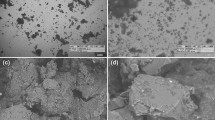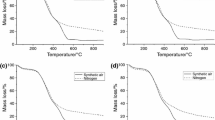Abstract
The quality control is vital for the safety and efficacy of herbal medicines. However, the quality of standardization is most difficult because the studies do not cover this step. The objective of this study was quality standardization of herbal drugs of Spondias dulcis Parkinson. The leaves were dried and ground to a powder. The plant drug was evaluated by parameters of mean particle size (417.85 μm), apparent density (0.37 ± 0.01 g mL−1), moisture content (7.96 ± 0.35%), loss on drying (7.33 ± 0.09%), pH (3.90 ± 0.01), total ash (12.66 ± 0.23%), acid insoluble ash (3.22 ± 0.20%) and aqueous extractives (24.00 ± 3.28%). Phytochemical screening revealed the presence of flavonoids and tannins. Microbiological analysis presented a total count within the recommended limits and the absence of pathogenic microorganisms. The infrared spectroscopy (FTIR) and thermal analysis (TG/DTA) showed that physical and chemical processes occurred. The FTIR fingerprint has been characterized by characteristic peaks. The TG curves present six steps, and DTA curve presents three events. The results provide the scientific data for the proper identification and establishment of standards for future investigations and applications.


Similar content being viewed by others
Abbreviations
- DTA:
-
Differential thermal analysis
- DTG:
-
Derivative thermogravimetry
- EMB:
-
Eosin methylene blue
- FTIR:
-
Infrared spectroscopy with Fourier transform
- GC:
-
Gas chromatography
- HPLC:
-
High-performance liquid chromatography
- TG:
-
Thermogravimetry
- TLC:
-
Thin-layer chromatography
- TSI:
-
Triple sugar and iron agar
- XLD:
-
Xylose lysine deoxycholate agar
References
Alencar LCB, Chaves TP, Santos JS, Nóbrega FP, Araújo RM, Santos VL, Felismino DC, Medeiros ACD. Efeito modulador do extrato de plantas medicinais do gênero Spondias sobre a resistência de cepas de Staphylococcus aureus à Eritromicina. Rev Ciênc Farm Básica Apl. 2015;36:111–6.
Islam SMA, Ahmed KAT, Manik MK, Wahid MDA, Kamal CSI. A comparative study of the antioxidant, antimicrobial, cytotoxic and thrombolytic potential of the fruits and leaves of Spondias dulcis. Asian Pac J Trop Biomed. 2013;3:682–91.
Ganguly A, Saha D, Saha SK. Chemical and biological investigations of Spondias dulcis—a study. 1st ed. Saarbrucken: LAP Lambert Academic Publish; 2014.
Cartaxo SL, Souza MMA, Albuquerque UP. Medicinal plants with bioprospecting potential used in semi-arid northeastern Brazil. J Ethnopharmacol. 2010;131:326–42.
Ardealean F, Moaca EA, Pacurariu C, Antal DS, Dehelean C, Toma CC, Dragan S. Invasive Polygonum cuspidatum: physico-chemical analysis of a plant extract with pharmaceutical potential. Stud Univ VG SSV. 2016;26:415–21.
Chaves TP, Fernandes FHA, Santana CP, Santos JS, Medeiros FD, Felismino DC, Santos VL, Catão RMR, Coutinho HDM, Medeiros ACD. Evaluation of the Interaction between the Poincianella pyramidalis (Tul.) LP Queiroz extract and antimicrobials using biological and analytical models. PLoS ONE. 2016;11(5):e0155532.
Ighodar OM, Akinloye OA, Ugbaja RN, Omotaise SO, Faokinla O. FT-IR analysis of Sapium ellipticum (Hochst) pax ethanol leaf extract and its inhibitory effects on pancreatic α-amylase and intestinal α-glucosidase activities in vitro. EJBAS. 2016;3:343–9.
Brandão DO, Guimarães GP, Santos RL, Ramos Júnior FJL, Silva KMA, Souza FS, Macedo RO. Model analytical development for physical, chemical, and biological characterization of Momordica charantia vegetable drug. J Anal Methods Chem. 2016. https://doi.org/10.1155/2016/7528297.
Fernandes FHA, Santana CP, Santos RL, Correia LP, Conceição MM, Macedo RO, Medeiros ACD. Characterization of dried extract of medicinal plant by DSC and analytical techniques. J Therm Anal Calorim. 2013;113:443–7.
Souza-Moreira TM, Salgado HRN, Pietro RCLR. O Brasil no contexto de controle de qualidade de plantas medicinais. Rev Bras Farmcogn. 2010;20:435–40.
Who, World Health Organization. Quality control methods for herbal materials. 1st ed. Geneve: WHO Press; 1998.
Cavalcanti AC, Gomes ANP, Porto NM, Agra MF, Moura TFAL, Oliveira EO. Pharmacognostic evaluation of Cissampelos sympodialis Eichl leaves. S Afr J Bot. 2014;93:70–8.
Fernandes FHA, Salgado HRN. Gallic acid: review of the methods of determination and quantification. Crit Rev Anal Chem. 2016;46:257–65.
Kumar S, Pandey AK. Chemistry and biological activities of flavonoids: an overview. Sci World J. 2013. https://doi.org/10.1155/2013/162750.
Ghisleni DDM, Braga MS, Kikuchi IS, Brasoveanu M, Nemtanu R, Dua K, Pinto TJA. The microbial quality aspects and decontamination approaches for the herbal medicinal plants and products: an in-depth review. Curr Pharm Des. 2016;22:4664–87.
Outuki PM, Francisco LMB, Hoschied J, Bonifácio KL, Barbosa DS, Cardoso MLC. Development of arabic and xanthan gum microparticles loaded with an extract of Eschweilera nana Miers leaves with antioxidant capacity. Colloids Surf A. 2016;490:103–12.
Fernandes FHA, Santana CP, Silva PCD, Simões MOS, Kaneko TM, Medeiros ACD. Development of a sunscreen by thermal compatibility study using Schinopsis brasiliensis Engler extract as preservative. J Therm Anal Calorim. 2018;131:753–63.
Fernandes FHA, Almeida VE, Medeiros FD, Silva PCD, Simões MOS, Véras G, Medeiros ACD. Evaluation of compatibility between Schinopsis brasiliensis Engler extract and pharmaceutical excipients using analytical techniques associated with chemometric tools. J Therm Anal Calorim. 2016;123:2531–42.
Klein T, Longhini R, Bruschi ML, Mello JPC. Microparticles containing guaraná extract obtained by spray-drying technique: development and characterization. Rev Bras Farmacogn. 2015;25:292–300.
Osorio C, Carriazo JG, Barbosa H. Thermal and structural study of guava (Psidium guajava L.) powders obtained by two dehydration methods. Quim Nova. 2010;34:636–40.
Correia LP, Procópio JVV, Santana CP, Santos AFO, Medeiros HMC, Macedo RO. Characterization of herbal medicine with different particle sizes using pyrolysis GC/MS, SEM, and thermal techniques. J Therm Anal Calorim. 2013;111:1691–8.
Correia LP, Santana CP, Silva KMA, Ramos Júnior FJL, Lima RSC, Souza FS, Medeiros ACD, Macedo RO. Physical and chemical characteristics of Maytenus rigida in different particle sizes using SEM/EDS, TG/DTA and pyrolysis GC–MS. J Therm Anal Calorim. 2018;131:743–52.
Liu H, Wang C, Zhao W, Yang S, Hou X. Pyrolysis characteristics and kinetic modeling of Artemisia apiacea by thermogravimetric analysis. J Therm Anal Calorim. 2018;131:1783–92.
Cuinica LG, Macedo RO. Thermoanalytical characterization of plant drug and extract of Urtica dioica L. and kinetic parameters analysis. J Therm Anal Calorim. 2018. https://doi.org/10.1007/s10973-018-6986-4.
Leite RS, Souza VG, Salvador IS, Oliveira AH, Lima Neto A, Basilio IJLD, Aragão CFS, Macedo RO, Souza FS. Evaluation of compatibility between dried extracts of Myracrodruon urundeuva Allemão and pharmaceutical excipients by TG and DTA. J Therm Anal Calorim. 2018. https://doi.org/10.1007/s10973-017-6842-y.
Cartaxo-Furtado NAO, Castilho ARF, Freires IA, Santana CP, Sampaio TO, Xavier MA, Medeiros ACD, Alves HS, Costa EMMB, Rosalen PL, Pereira JV. Physicochemical characterization of a new raw material obtained from leaves of Syzygium cumini (L.) Skeel (Myrtaceae). J Therm Anal Calorim. 2017;127:1137–41.
Acknowledgements
The authors gratefully acknowledge Maria de Fátima Moretti for technical support.
Funding
This work was supported by PADC—FCFAr Unesp, CNPq and Capes Foundation.
Author information
Authors and Affiliations
Corresponding author
Ethics declarations
Conflict of interest
No potential conflict of interest was reported by the authors.
Human or animal rights
This article does not contain any studies with human or animal subjects.
Rights and permissions
About this article
Cite this article
Fernandes, F.H.A., Boylan, F. & Salgado, H.R.N. Quality standardization of herbal medicines of Spondias dulcis Parkinson using analytical and microbiological analysis. J Therm Anal Calorim 134, 1923–1928 (2018). https://doi.org/10.1007/s10973-018-7486-2
Received:
Accepted:
Published:
Issue Date:
DOI: https://doi.org/10.1007/s10973-018-7486-2




